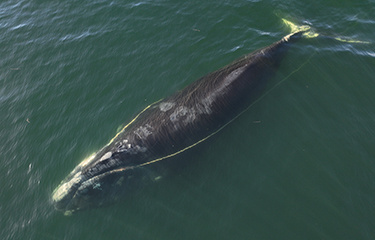NOAA Fisheries announced a North Atlantic right whale was spotted entangled by ropes off the coast of Georgia, marking the third right whale entanglement discovered in 2023.
The whale, nicknamed “Nimbus,” was spotted entangled 13 miles off the coast of Jekyll Island, Georgia, U.S.A. According to NOAA, a team of authorized responders and experts managed to remove 375 feet of rope from the whale, leaving a “short segment” in its mouth that the responders are “optimistic” will dislodge over time.
NOAA added that the organization plans to analyze the rope to determine its origin, “if possible.”
On 8 January, NOAA reported a right whale trapped by a significant entanglement that likely caused a serious injury, meaning the whale will likely die as a result. And on 18 January, a second right whale was found entangled five miles south of Provincetown, Massachusetts, U.S.A. An effort to disentangle the whale was unsuccessful. NOAA said that authorized responders and experts are continuing to work to resight the whale and make a new effort tiodisentangle it.
Entanglement in fishing gear has been a hot-button topic for the U.S. lobster industry, which has been fighting back against new rules that fishery advocates and the state’s congressional delegation say would create dire economic consequences for the industry. Fishermen were granted a six-year reprieve by a last-minute addition to the U.S. Senate’s omnibus funding budget, a move applauded by politicians from the U.S. state of Maine but were denounced by environmental groups. Environmental grups argue more must be done to preserve the remaining 350 or so individual right whales in existence; the lobster fishery has fought back against the pressure, pointing out that no North Atlantic right whale death has ever been attributed to Maine lobster gear.
Meanwhile, the administration of U.S. President Joe Biden recently declined a petition from environmental NGO Oceana designed to create more rules protecting whales from ship strikes, which have been directly linked to right whale mortalities. Oceana's petition called for modifying seasonal speed zones, implementing a new “dynamic speed zone” framework, and expanding the class of boats under speed restrictions in the Southeast United States.
Many of the emergency measures in the petition are already on track for implementation in June 2023, but Oceana said thetimetable should be accelerated.
“Their refusal to take immediate action continues the agency’s history of delays and leaves new mothers and calves in danger,” Oceana Campaign Director Gib Brogan said. “These whales are particularly vulnerable to boat strikes because they spend their time at the water’s surface. In just the last week, half-a-dozen right whale sightings have occurred outside of existing protection areas and none of the whales in the Southeast region are protected from smaller boats that can and do kill right whales. The government’s own assessment clearly shows that more needs to be done for this species to reduce the risk of whale mortality.”
Right whale slow zones currently exist and are used by NOAA – on 30 January, NOAA announced the extension of one zone east of Ocean City, Maryland, U.S.A., after the detection of right whales in the region. However, the slow zones are voluntary, meaning mariners are merely asked to avoid or transit slowly inside the area and face no punishment for violating the zonal speed limits.
An Oceana study investigating similar Canadian slow zones showed ships typically ignore voluntary slow zones, finding 72 percent of the ships surveyed didn’t comply with a 10-knot slow zone in the Cabot Strait in the Gulf of Saint Lawrence, an area known to frequently contain North Atlantic right whales.
Photo courtesy of the Georgia Department of Natural Resources/NOAA Fisheries







